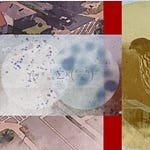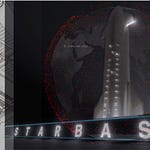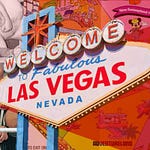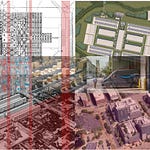Hello Interactors,
This has been a wild week in our neighborhood. It was a car enthusiasts dream. Too bad our family’s biggest car enthusiast, my son, was busy working his summer job. It was guys like him that got America hooked on cars. And now our planet is cooked. Is it a lost cause?
As interactors, you’re special individuals self-selected to be a part of an evolutionary journey. You’re also members of an attentive community so I welcome your participation.
Please leave your comments below or email me directly.
Now let’s go…
GET A HORSE
Flying down the freeway I see a woman climb out of the sunroof of her car. She’s alone. A semi-truck pulls alongside as she leaps from the car onto the bed of the trailer. Pulling alongside the car in front of her, I see the driver put on a black blindfold. He crosses his arms across his chest like he’s preparing for a collision. Just then, the truck in front of him slams on their brakes. His car comes to a screeching halt as does the woman’s empty car behind him. The man lifts his blindfold, stares into a camera mounted on his dashboard, and gruffly states, “I guess it works.”
This isn’t a stunt I watched on Tik Tok, but a Hyundai Genesis ad from 2015. It starts with a voiceover from the sacrificial stuntman in the lead car, “The challenge is to show the driver assist features in an exciting way. But you guys, it seems, are a little hard to excite. Maybe the only way is to put our own lives on the line. Proof, through jeopardy.”
Our neighborhood was blocked off this week to film a Genesis car commercial. Nothing this dramatic, they just drove their luxury cars around the block. They descended a hill that features an unobstructed distant view of the Seattle skyline beyond a glistening blue Lake Washington. Fancy cars in a fancy suburb. A suburb whose name features prominently on the Costco toilet paper most of you wipe your fanny biscuits with – Kirkland. Maybe we’re not so fancy after all, but our neighborhood does have nice views.
We didn’t see stunt doubles hurling themselves from the sunroofs of luxury cars that day. In fact, we barely saw a single human being. The windows were tinted black, and the streets were empty, except for the police and production assistants. I stepped on the sidewalk to walk down the street and got yelled at by a Kirkland cop. “SIR! PLEASE BACK OFF THE SIDEWALK!” They, like the drivers, were being instructed by the commercial’s director on a walkie-talkie from inside a customized SUV. It had a massive camera boom stretching from the roof over the front end – like a carrot dangling in front of a mule.
The truth is, it’s not just car commercials that wish there were no pedestrians on the street. Anytime any of us get behind the wheel of a car we wish the streets were free of people. And bikes. And, yes, other cars and busses too. It’s no wonder most every car commercial features a single driver on a smooth open road…void of people and cars. What bliss. No worries, no conflicts, no delays, just me on my street going between my house and my Costco to hoard my toilet paper.
But believe it or not, people needed to be convinced automobiles were useful – let alone desirable. It wasn’t a car commercial that convinced them of this. It was their neighborhood car enthusiasts. People needed to be convinced of the promise of new machines. Innovation doesn’t just sell itself. Sociologists who study social movements say innovations that shape society are framed by “ideological activists who exploit political opportunities to mobilize resources.”1 They participate in what sociologists call ‘meaning-work’ which demonstrates their ideology as being meaningful, valid, and appropriate.
New industries become broadly legitimized only after these industry activists are successful in converting radical concepts into something useful. Elements of a larger belief system must be framed in the context of daily life. So, automobile clubs organized events that demonstrated the benefits of the automobile. This idea was taken from bicycle clubs of the 1800s who used bicycle races to demonstrate the utility, reliability, and health benefits of cycling. Most automobile clubs were born out of bicycle clubs. Both were elite modes of transport using the latest industrial technology. The first automobiles were simply motorized quadricycles. Those motors were especially useful for getting up a hill.
Biking up hills is hard. Biking for long distances requires endurance. And what happens if your bike breaks down? Reliability of both bikes and horse carriages was a big deal. These challenges of everyday life were just what automobile industry activists (i.e. automobile clubs) needed to demonstrate the benefits of an automobile. So, they organized demonstration events that included hill climbs and races pitting one car maker against another to see which was the fastest and most reliable.
The first was on Thanksgiving of 1895 financed by the Times-Herald. Eleven cars were invited, five showed up and only two managed to finish the event. The winner was awarded $10,000 ($350,000 today) and it went to the Duryea Brothers –America’s first automaker. Their gasoline car topped out at 8MPH in below freezing temperatures…in the snow. Reminding people of the challenges of taking a horse and buggy through the snow, the Times-Herald reported that the car made it “through deep snow and along ruts that would have tried horses to the utmost.”
But these events weren’t universally convincing. In 1896, an event organized by the Rhode Island State Fair Association featured an electric car. The Riker Electric won the race and $5,000 but the crowd was underwhelmed. They began chanting, “GET A HORSE. GET A HORSE. GET A HORSE.” That refrain became a popular expression used to make fun of automobile drivers. For years people would yell as they passed, “GET A HORSE!”
By July of 1905, the publication Horseless Age, declared the beginning of the American dominant car culture. After a national reliability event by the American Automobile Association (AAA), The Glidden Tour, they reported that it “proved the automobile is now almost foolproof. It has proved that American cars are durable and efficient...it has strengthened our belief in the permanence of the motor car.’’
A year later, in 1906, Munsey Magazine also declared the end of making fun of the automobile by writing, the “uncertain period of the automobile is now past. It is no longer a theme for jokers and rarely do we hear the derisive expression ‘Get a horse.’” And three years later, in 1909, Charles Duryea atoned that the “novelty of the automobile has largely worn off.” Soon Ford started pulling out of demonstration events and became the first mass produced reliable car in the world. The belief system of those early innovation activists had taken hold. Their meaning-work was done. They had demonstrated and convinced the public that their once radical inventions were more useful, usable, and desirable than horses, buggies…and bikes.
THE GENIE GETS OUT OF THE BOTTLE
With the public convinced and nationwide reliability events tapering off, automobile activists turned their attention to roads. The Good Roads Movement had been around since the 1880s and was started by a bicycle club, the League of American Wheelman. But in 1910 that organizations efforts were overshadowed by the Automobile Association of America (AAA). By the 1920s, automobiles were competing for space with streetcars that were ubiquitous in cities big and small across the country. Streetcar systems were so vast you could almost traverse the country by streetcar city to city. But for the first time, funds and space for public rail infrastructure had competition. Should tax dollars be spent on developing and maintaining rail for trains and streetcars or roads for bikes and automobiles?
Meanwhile, large motor coaches were also being produced. One of the first manufacturers and operators in America was John D. Hertz of Hertz rental car fame. He had been operating busses in Chicago since 1916, and in 1923 started the Yellow Coach Manufacturing Company, a subsidiary of another popular name, the Yellow Cab Company. He went on to start other companies with visions of bringing busses and busing to all of America.
In 1925 General Motors (GM) bought a controlling stake in Yellow Coach and changed the name to Yellow Truck and Coach Manufacturing Company. Then, in 1926 Yellow Coach purchased the struggling New York Railways Corporation with the idea of converting it to a bus company. By 1930, the depression put added pressure on the competition for infrastructure funds. Financially struggling streetcars companies were often forced by local governments to lease street access and pay for rail maintenance and services (like snow removal). Companies were also sometimes forced to cap fare prices to protect lower income residents from getting priced out of public transportation by private firms. By the 1930s most streetcars were worn down and their companies bankrupt. It made them easy prey for companies like General Motors to buy them out.
And so they did. GM started a subsidiary called United Cities Motor Transport (UCMT) with the sole purpose of buying out streetcar companies and converting them to bus lines in small cities. They succeeded in Saginaw, Michigan, and Springfield, Ohio and then tried Portland, Oregon. But the American Transit Association, a public transit advocacy group, stepped in and the UCMT was forced to dissolve in 1935. But it didn’t stop General Motors. That same year they converted a streetcar in New Jersey to a ‘trackless trolly’ – a bus attached to an electric wire that could detach to pick up passengers in lower populated areas. An idea that is alive to this day.
The conversion from tracks to wheels was catching on. In 1936, two brothers in Minnesota who had been modestly busing school children and miners since 1920, either decided or were ‘encouraged’ to expand. They announced a reorganization of their company, National City Lines, "for the purpose of taking over the controlling interest in certain operating companies engaged in city bus transportation and overland bus transportation."
That same year, 1936, this tiny outfit bought 13 streetcar companies in three states in the Midwest. They pushed westward and south to three more states in 1937. They also formed a subsidiary in Oakland, California called Pacific City Lines (PCL) with the intention of converting streetcar operations on the west coast to bus lines. In 1938 they approached GM’s Yellow Coach company to help finance further expansion. By 1939 they had secured funding from not only GM, but Firestone Tire, Standard Oil of California, Phillips Petroleum, and Mack Trucks. By the end of 1939, just three years after owning and operating a couple rural busses in Minnesota, National City Lines took control of 29 local streetcar and public transportation companies in 27 cities across 10 states. By 1947 that grew to 46 systems, 45 cities, and 16 states.
That also marked the end of the buying spree. In 1947 they were indicted on these two counts of conspiracy by the Federal District Court of Southern California: 'Conspiring to acquire control of a number of transit companies, forming a transportation monopoly' and 'Conspiring to monopolize sales of buses and supplies to companies owned by National City Lines.' In 1948 the case was appealed by the U.S. Supreme Court and they ordered the case be moved to the Midwest in the Federal District Court in Northern Illinois.
A year later, in 1949, General Motors, Standard Oil of California, Firestone and others were convicted of conspiring to monopolize the sale of buses and related products to local transit companies controlled by National City Lines and other companies. But they were acquitted on charges of conspiracy to monopolize the ownership of streetcar and other public transportation companies. GM was fined a paltry $5000 ($62,000 today) dollars for their involvement. Their treasurer, also the director of Pacific City Lines was fined $1. That almost seems like a wink and nod more than a punishment. That one man single-handedly dismantled a $100 million electric public transportation system up and down the west coast of the United States.

In Los Angeles alone, 280 million passengers a year were using the electric streetcar system.2 They were forced into buses or cars – if they could afford them. By 1953, just four years after the great General Motors Streetcar Conspiracy people were already complaining of traffic in LA. Within a decade, nearly four million cars were crawling around the Los Angeles Metropolitan area. The era of automobile dependency in the United States was in full swing. And there’s no getting that genie back in the bottle.
SAFETY FOR WHOM?
The CEO of GM, Alfred P. Sloan, wasn’t just pooling money with his cronies to buy out electric streetcar companies. Back in 1932, the same time he was conspiring to monopolize, he also created the ‘National Highway Users Conference’. He filled it with automobile, oil, and highway construction executives as a non-profit lobbying group intent on bringing an end to the government funding of mass transportation. This resulted in the creation of the U.S. Highway Trust Fund which was then used to fund the creation of the U.S. Interstate Highway System. Between 1952 and 1970 the U.S. government spent nearly two billion dollars on highways. Rail systems got just one quarter of a million.3
1970 also marked the year the ‘National Highway Users Conference’, ‘Automotive Safety Foundation’, and the ‘Auto Industries Highway Safety Committee’ were merged to form the ‘Highway Users Federation’. In 1995 the name was changed to the 'American Highway Users Alliance’ which to this day is “dedicated to more successful and aggressive issue advocacy on behalf of the highway community.”4 They went on to lead a “successful national lobbying, media and grassroots advocacy campaign to enact legislation officially designating and funding the National Highway System.” A year later, in 1996, Al Gore, the Nobel prize winner for climate change advocacy, keynoted their 40th anniversary conference. An inconvenient truth.
This organization was also the member of the Global Climate Coalition from 1989 to 2001. This was the largest climate policy group in the world. It was an international coalition that opposed actions to reduce greenhouse gas emissions and challenged the science behind climate change. They also played a significant role in the United States denying ratification of the 1992 Kyoto Protocol.
In 2004 a former U.S. Federal Highway Administration staffer, Greg Cohen, became the CEO of the organization. He was behind the Safe, Accountable, Flexible, Efficient Transportation Equity Act: A Legacy for Users, better known as SAFETE-LU. This George W. Bush administration bill included funding for the purchase of land in Illinois for freeway expansion. Bush worked directly with the Speaker of the House, Dennis Hastert, on the bill. It turned out Hastert owned the very land slated for freeway expansion. The celebration of the passing of the bill was held at the headquarters of the road construction equipment maker, Caterpillar.
Four months later Hastert enjoyed a 500% profit in the sale of his land and his net worth went from $300,000 to over $6 million. Hastert went on to be convicted on felony charges, but not for swindling taxpayers’ dollars. He was sent to prison for serial sexual molestation of young boys. He is the highest-ranking U.S. elected official to serve a prison sentence. Will Trump dethrone him? Just last April, the former Highway Alliance CEO, Greg Cohen, received an award by the ‘Road Gang’ (as those in the organization like to call themselves) for his “significant, exemplary contributions to the highway industry.”
In 2009 the ‘Road Gang’ opposed the American Clean Energy and Security Act. This was the first U.S. bill passed by a branch of the U.S. Federal Government intent on curbing heat-trapping gases responsible for the climate crisis. The ‘Road Gang’ said the “bill will dramatically raise the price of highway fuel through a hidden tax” and that it may “raise the price of gasoline by 77 cents over the next decade.” Worse yet, they worried “none of the revenue raised will be spent on highways.”
These caustic climate curmudgeons, car conspirators, tire tycoons, and oil and gas goons are the modern-day automobile enthusiast club. In sociological terms they are ideological activists who exploit financial and political opportunities to mobilize resources. For over a century their ideologically vacuous, homogenous, and one-sided promise of automobility is alive and well but it is also killing us – even as it perpetually promises to save us.
Yet we still need demonstrations to convince us. Now safety and reliability are demonstrated by professional stunt drivers filmed on a smooth open road. Desirable luxury automobiles are filmed in a bucolic low-density suburban neighborhood void of cars and people. Ironically, our Kirkland neighborhood was planned and designed in the 1800s – complete with alleys designed to hide buggies, bikes, and carbon belching Buicks. Streets were public spaces where kids could play, and neighbors talked to one another. As car enthusiasts took over so did city planners and city councils hellbent on accommodating there promises. Now these enthusiasts are our elected officials, city planners, and civil engineers. In their mind, most of them anyway, the only meaningful, valid, and appropriate use of the street is for cars. A place where to be safe you need Hollywood production assistants on every corner and a cop in the intersection yelling, “SIR! PLEASE BACK OFF THE SIDEWALK!” It makes me want to yell back, “GET A HORSE!”
Institutional activism in the early American automobile industry. Hayagreeva Rao. Journal of Business Venturing. 2004.
The Ten Myths of Automobile Dependence. Peter Newman & Jeff Kenworthy. 2000.
Ibid.
Historical Milestones Celebrating 75 Years of Advocacy. The Highway Users Federation. 2007.















Share this post